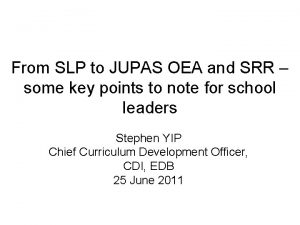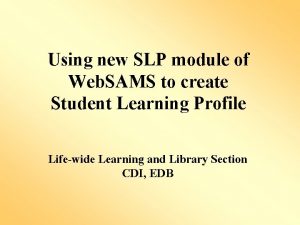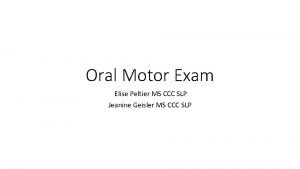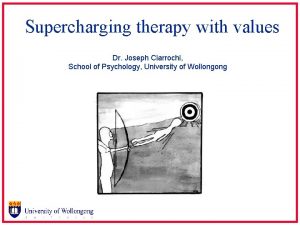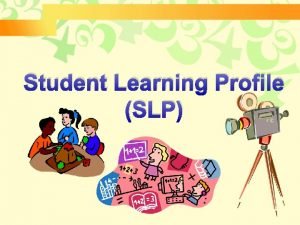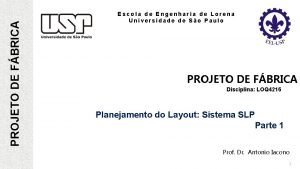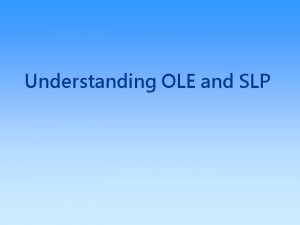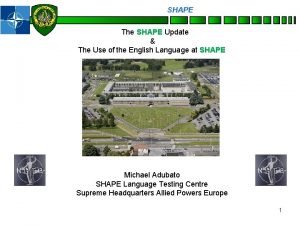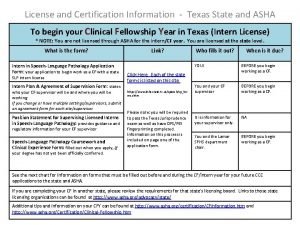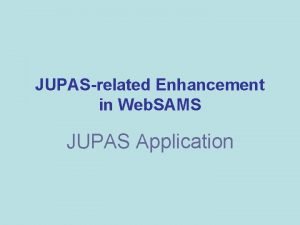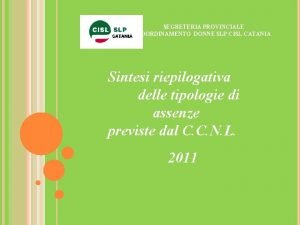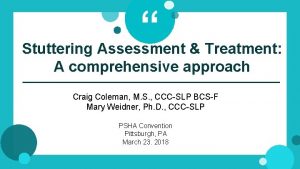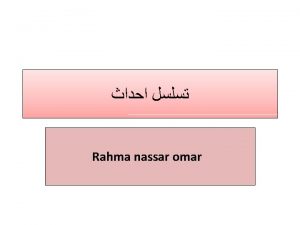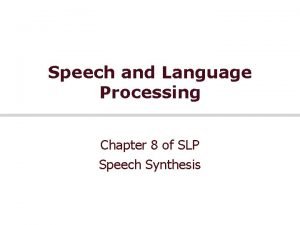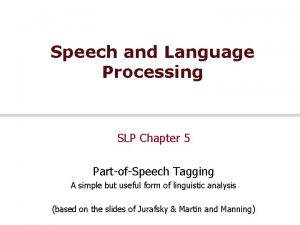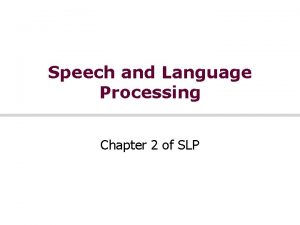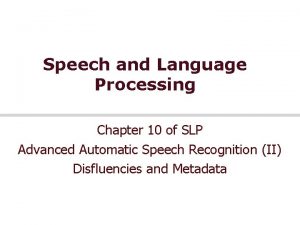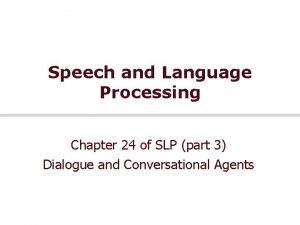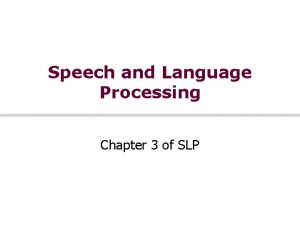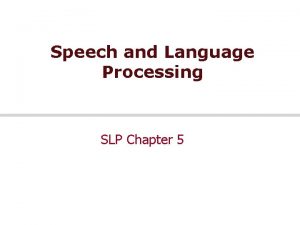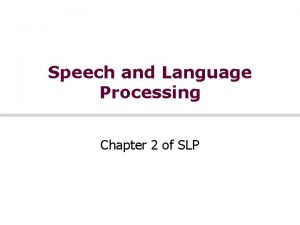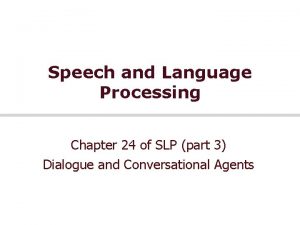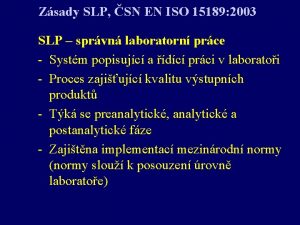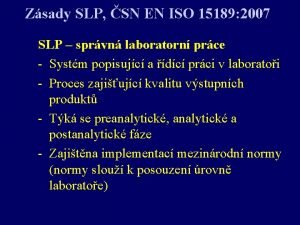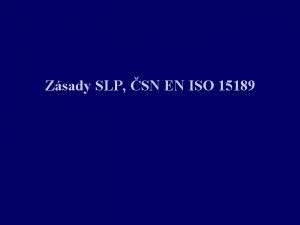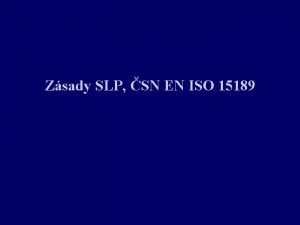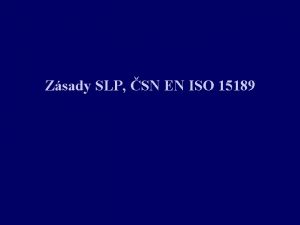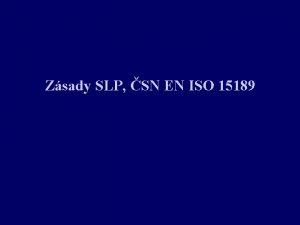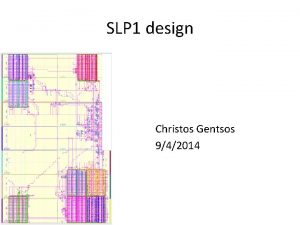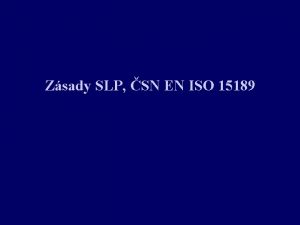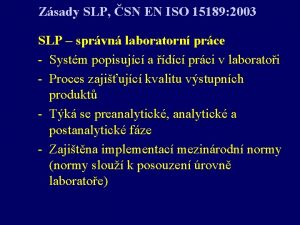Speech and Language Processing Chapter 8 of SLP

























- Slides: 25

Speech and Language Processing Chapter 8 of SLP Speech Synthesis / Waveform synthesis

Waveform Synthesis § Given: § String of phones § Prosody § Desired F 0 for entire utterance § Duration for each phone § Stress value for each phone, possibly accent value § Generate: § Waveforms 11/1/2020 Speech and Language Processing Jurafsky and Martin 2

Diphone TTS architecture § Training: § Choose units (kinds of diphones) § Record 1 speaker saying 1 example of each diphone § Mark the boundaries of each diphones, § cut each diphone out and create a diphone database § Synthesizing an utterance, § grab relevant sequence of diphones from database § Concatenate the diphones, doing slight signal processing at boundaries § use signal processing to change the prosody (F 0, energy, duration) of selected sequence of diphones 11/1/2020 Speech and Language Processing Jurafsky and Martin 3

Diphones § Mid-phone is more stable than edge: 11/1/2020 Speech and Language Processing Jurafsky and Martin 4

Diphones § mid-phone is more stable than edge § Need O(phone 2) number of units § Some combinations don’t exist (hopefully) § ATT (Olive et al. 1998) system had 43 phones § 1849 possible diphones § Phonotactics ([h] only occurs before vowels), don’t need to keep diphones across silence § Only 1172 actual diphones § May include stress, consonant clusters § So could have more § Lots of phonetic knowledge in design § Database relatively small (by today’s standards) § Around 8 megabytes for English (16 KHz 16 bit) 11/1/2020 Slide from Richard Sproat Speech and Language Processing Jurafsky and Martin 5

Voice § Speaker § Called a voice talent § Diphone database § Called a voice 11/1/2020 Speech and Language Processing Jurafsky and Martin 6

MBROLA § Difoon synthese systeem (open source) (Thierry Dutoit, Mons, België) Als ingrediënten opgeven, voor elke klank: § Foneem § Toonhoogte § Duur

MBROLA procedure Nodig: § MBROLA difoonset § Stuurgegevens in. pho fil fonemen, toonhoogtes, duren MBROLA maakt. wav file $mbrola/nl 2 woord. pho woord. wav

MBROLA synthese – duur (ms) – toonhoogte (Hz) ; Utterance: "Hallo!“ _ 100 120 h 96 A 48 l 76 5 100 75 120 o 224 25 85 _ 100 40 70 percentages –%

Prosodic Modification § Modifying pitch and duration independently § Changing sample rate modifies both: § Chipmunk speech § Duration: duplicate/remove parts of the signal § Pitch: resample to change pitch 11/1/2020 Text from Alan Black 10 Speech and Language Processing Jurafsky and Martin

Speech as Short Term signals 11/1/2020 Alan Black Speech and Language Processing Jurafsky and Martin 11

Duration modification § Duplicate/remove short term signals 11/1/2020 Slide from Richard Spro 12 Speech and Language Processing Jurafsky and Martin

Duration modification § Duplicate/remove short term signals 11/1/2020 Speech and Language Processing Jurafsky and Martin 13

Pitch Modification § Move short-term signals closer together/further apart 11/1/2020 Slide from Richard Sproat Speech and Language Processing Jurafsky and Martin 14

TD-PSOLA ™ § Time-Domain Pitch Synchronous Overlap and Add § Patented by France Telecom (CNET) § Very efficient § No FFT (or inverse FFT) required § Can modify Hz up to two times or by half 11/1/2020 Slide from Richard Sproat Speech and Language Processing Jurafsky and Martin 15

TD-PSOLA ™ § Time-Domain Pitch Synchronous Overlap and Add § Patented by France Telecom (CNET) § § § Windowed Pitch-synchronous Overlap-and-add Very efficient Can modify Hz up to two times or by half 11/1/2020 Speech and Language Processing Jurafsky and Martin 16

Unit Selection Synthesis § Generalization of the diphone intuition § Larger units § From diphones to sentences § Many many copies of each unit § 10 hours of speech instead of 1500 diphones (a few minutes of speech) 11/1/2020 Speech and Language Processing Jurafsky and Martin 17

Unit Selection Intuition § Given a big database § Find the unit in the database that is the best to synthesize some target segment § What does “best” mean? § “Target cost”: Closest match to the target description, in terms of § Phonetic context § F 0, stress, phrase position § “Join cost”: Best join with neighboring units § Matching formants + other spectral characteristics § Matching energy § Matching F 0 11/1/2020 Speech and Language Processing Jurafsky and Martin 18

Targets and Target Costs § Target cost T(ut, st): How well the target specification st matches the potential unit in the database ut § Features, costs, and weights § Examples: § /ih-t/ +stress, phrase internal, high F 0, content word § /n-t/ -stress, phrase final, high F 0, function word § /dh-ax/ -stress, phrase initial, low F 0, word “the” 11/1/2020 Speech and Language Processing Jurafsky and Martin 19

Target Costs § Comprised of k subcosts § § § Stress Phrase position F 0 Phone duration Lexical identity § Target cost for a unit: 11/1/2020 Slide from Paul Taylor Speech and Language Processing Jurafsky and Martin 20

difoonaansluiting(skosten) § pa § ka § ta § ap § ak § at Dit zijn meestal zes verschillende opnamen, maar dat geeft spectrale verschillen bij de aansluiting: pa – ap, pa – ak, pa – at ka – ap, ka – ak, ka – at ta – ap, ta – ak, ta – at

Join (Concatenation) Cost § Measure of smoothness of join § Measured between two database units (target is irrelevant) § Features, costs, and weights § Comprised of k subcosts: § Spectral features § F 0 § Energy § Join cost: 11/1/2020 Slide from Paul Taylor Speech and Language Processing Jurafsky and Martin 22

Total Costs § Hunt and Black 1996 § We now have weights (per phone type) for features set between target and database units § Find best path of units through database that minimize: § Standard problem solvable with Viterbi search with beam width constraint for pruning 11/1/2020 Slide from Paul Taylor Speech and Language Processing Jurafsky and Martin 23

11/1/2020 Speech and Language Processing Jurafsky and Martin 24

Unit Selection Summary § Advantages § Quality is far superior to diphones § Natural prosody selection sounds better § Disadvantages: § Quality can be very bad in places § HCI problem: mix of very good and very bad is quite annoying § Synthesis is computationally expensive § Can’t synthesize everything you want: § Diphone technique can move emphasis § Unit selection gives good (but possibly incorrect) result 11/1/2020 Slide from Richard Sproat Speech and Language Processing Jurafsky and Martin 25
 Slp jupas sample
Slp jupas sample Jupas ole sample
Jupas ole sample Fsu slp bridge program
Fsu slp bridge program Acoact
Acoact Sams slp
Sams slp Jupas slp sample
Jupas slp sample Oral motor exam
Oral motor exam Bundessprachenamt slp test
Bundessprachenamt slp test Slp dominance
Slp dominance Slp student
Slp student Slp
Slp Nss slp
Nss slp Slp bsc
Slp bsc Personnel
Personnel Slp dse
Slp dse New academic structure
New academic structure Texas slp jurisprudence exam
Texas slp jurisprudence exam Robyn walsh slp
Robyn walsh slp Betvity
Betvity Slp 3332
Slp 3332 Slp cisl catania
Slp cisl catania Slp quotes
Slp quotes Craig coleman slp
Craig coleman slp Vmware cim slp
Vmware cim slp Multiversidad latinoamericana slp
Multiversidad latinoamericana slp Slp consult
Slp consult

